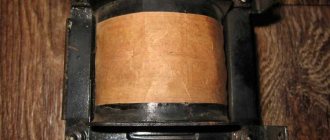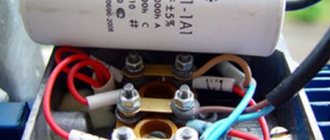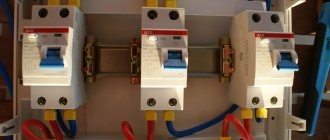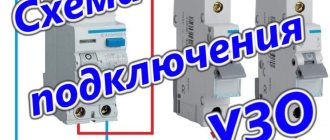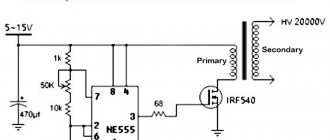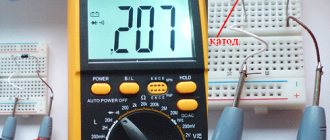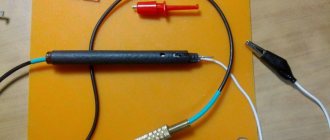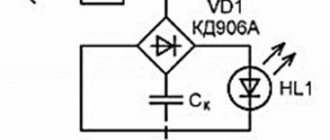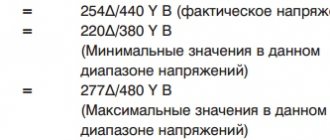Design features
Before starting work, understand the design of the IM (induction motor).
The device consists of two elements - a rotor (moving part) and a stator (fixed unit).
The stator has special grooves (recesses) into which the winding is placed, distributed in such a way that the angular distance is 120 degrees.
The windings of the device create one or more pairs of poles, the number of which determines the frequency with which the rotor can rotate, as well as other parameters of the electric motor - efficiency, power and other parameters.
When an asynchronous motor is connected to a three-phase network, current flows through the windings at different time intervals.
A magnetic field is created that interacts with the rotor winding and causes it to rotate.
In other words, a force appears that turns the rotor at different time intervals.
If you connect the IM to a network with one phase (without performing preparatory work), the current will appear in only one winding.
The torque generated will not be enough to move the rotor and keep it spinning.
That is why, in most cases, the use of starting and operating capacitors is required to ensure the operation of a three-phase motor. But there are other options.
What can be redone
Low-power 380 Volt electric motors are suitable for conversion: up to 3 kW. Theoretically, powerful motors are also reconnected. But this will additionally entail the installation of a separate circuit breaker in the electrical panel and special wiring. And this work becomes meaningless if it suddenly turns out that the input cable cannot carry such a load.
Read also: How to run wires into a panel
Even if your network carries high loads, and you managed to convert a 3 kW motor from 380 to 220 Volts, you will be upset the first time you put it into operation. The launch will be difficult. You will decide that the work was in vain. Therefore, if you redo it, then it will be low-power models.
How to connect an electric motor from 380 to 220V without a capacitor?
As noted above, to start an electric motor with a squirrel-cage rotor from a single-phase network, a capacitor is most often used.
It is this that ensures the device starts at the first moment after the single-phase current is supplied. In this case, the capacity of the starting device should be three times higher than the same parameter for the working capacity.
For motors with a power of up to 3 kilowatts and used at home, the price of starting capacitors is high and sometimes comparable to the cost of the motor itself.
Consequently, many are increasingly avoiding containers used only at the moment of start-up.
The situation is different with working capacitors, the use of which allows you to load the motor at 80-85 percent of its power. If they are absent, the power indicator may drop to 50 percent.
However, capacitorless starting of a 3-phase motor from a single-phase network is possible thanks to the use of bidirectional switches that operate for short periods of time.
The required torque is provided by the displacement of phase currents in the windings of the IM.
Today, two schemes are popular, suitable for motors with power up to 2.2 kW.
It is interesting that the start-up time of the IM from a single-phase network is not much lower than in the usual mode.
The main elements of the circuit are triacs and symmetrical dinistors. The first are controlled by multi-polar pulses, and the second by signals coming from the half-cycle of the supply voltage.
Scheme No. 1.
Suitable for 380 Volt electric motors up to 1,500 rpm with delta windings.
The RC circuit acts as a phase-shifting device. By changing the resistance R2, it is possible to achieve a voltage across the capacitor that is shifted by a certain angle (relative to the household network voltage).
The main task is performed by the symmetrical dinistor VS2, which at a certain point in time connects a charged capacitance to the triac and activates this switch.
conclusions
It is possible to obtain 380 volts from a 220 V network in several ways. The most effective way to use an electronic inverter is:
- stable current parameters;
- safe operation;
- ensuring the declared output power;
- compact installation.
All of the above methods of converting 220 Volts to 380 work, therefore they have the right to exist. But you must be prepared for power loss and difficulties in achieving other current parameters, including its frequency characteristics.
How to connect via capacitors
First, decide which circuit is assembled on the ED. To do this, open the bar cover where the blood pressure terminals are output, and see how many wires come out of the device (most often there are six).
The designations are as follows: C1-C3 are the beginnings of the winding, and C4-C6 are its ends. If the beginnings or ends of the windings are combined with each other, this is a “star”.
The most difficult situation is if six wires simply come out of the housing. In this case, you need to look for the corresponding designations on them (C1-C6).
To implement a scheme for connecting a three-phase electric motor to a single-phase network, two types of capacitors are required - starting and working.
The first ones are used to start the electric motor at the first moment. As soon as the rotor spins to the required number of revolutions, the starting capacitance is excluded from the circuit.
If this does not happen, there may be serious consequences, including engine damage.
The main function is performed by working capacitors. Here it is worth considering the following points:
- Working capacitors are connected in parallel;
- The rated voltage must be at least 300 Volts;
- The capacity of the working capacitors is selected taking into account 7 µF per 100 W;
- It is desirable that the type of working and starting capacitor be identical. Popular options are MBGP, MPGO, KBP and others.
Price
3-pole circuit breakers, depending on the manufacturer, also differ in price. In the table below you can compare the cost of such electrical installation products from the most popular brands in the Russian Federation: IEK, Legrand, Schnider Electric and ABB:
Cost table for 3-pole circuit breakers leading on the Russian market
Video about switch polarity and connection methods
The video will be useful for beginners who want to understand the differences and functionality of single-pole, double-pole, 3-pole and 4-pole circuit breakers. How to connect them correctly and in what cases one or another machine should be used.
How to connect with reverse
There are situations in life when you need to change the direction of rotation of the motor. This is also possible for three-phase electric motors used in a household network with one phase and zero.
To solve the problem, it is necessary to connect one terminal of the capacitor to a separate winding without the possibility of breaking, and the second - with the possibility of transferring from the “zero” to the “phase” winding.
To implement the circuit, you can use a switch with two positions.
The wires from “zero” and “phase” are soldered to the outer terminals, and the wire from the capacitor is soldered to the central terminal.
Connecting 380V sockets
Having understood the main types and features, you can consider connecting a 380 V outlet. We will do this separately for each type.
Connecting 2P+PE and 3P+PE sockets
Let's start with the simplest connection of a 2P+PE socket. As the name suggests, for this we need two phase wires and one ground wire.
Socket 2P+PE
- Based on this, before making the connection, we need to determine the wire data. To do this, we need to decide on the distribution board in which the connection will be made, as well as on the circuit breaker of the appropriate power.
Note! To connect a 2P+PE socket we need a two-pole circuit breaker. In some cases, it is possible to use a three-pole machine, in which we will only use two poles. The rated voltage and rated current of this machine must correspond to the rated values of the socket.
Two-pole machine
- If you will make all the connections yourself, then first of all we run a cable or wire from the distribution board to the outlet. In this case, a three-core cable of the appropriate cross-section will suit us.
- Now we make the connection in the distribution board. First we connect the protective ground wire. To comply with PUE standards and facilitate the connection of the socket, it is advisable to use a yellow-green conductor. We connect it to the PE bus, which should go in the distribution board in addition to any automatic machines.
Connecting PE and N buses in the switchboard
- After this, we connect the phase conductors. They are connected to the terminals of the machine. Before connecting, make sure the machine is turned off.
- Now we connect directly to the outlet. First of all, we again connect the protective ground wire. Above, we have already decided on its labeling.
Note! If you do not know which contact to connect the protective grounding wire to, you can always determine this visually. According to the PUE standards, the design of any socket must ensure that the grounding contact is closed first. Because of this, the plugs have a longer blade to create a grounding circuit.
- After this, we connect the phase wires to the two remaining contacts. There may be two connection options: screw or clamp. Both options are quite reliable, but I personally prefer screw contacts.
3P+PE socket connection diagram
- The circuit diagram of a 380V socket of the 3P+PE type is almost identical to the connection of a 2P+PE socket. The only difference is the number of phase conductors, of which in this case we have three. In addition, for such a connection we only need a three-pole circuit breaker and a four-wire cable. Otherwise the connection is completely identical.
Three-pole machine
Connecting a 3P+PE+N socket
We will need the largest number of wires to connect a 3P+PE+N socket. But this does not mean at all that this type of connection is much more complicated.
Connection diagram for 3P+PE+N socket
As in the first two cases, it begins with transferring a cable or wire from the outlet to the distribution board. The cable must be five-core.
So:
- First of all, we connect the grounding conductor to the corresponding bus in the distribution board.
- After this we connect the neutral wire . PUE standards require the use of a blue cable core for this. The neutral bus in the distribution board is also usually marked in blue or with a corresponding letter marking.
- We connect the phase wires last . To do this, we place them on the output of a three-pole machine. Before connecting, make sure the machine is turned off.
Connecting a 3P+PE+N socket
- Now we connect directly to the outlet . First of all, by analogy with a 2P+PE socket, we install a protective grounding wire.
- Now we need to connect the neutral wire . It should be placed on the corresponding contact of the socket. It is usually signed "N". If there is no such marking, then it should be connected to the socket contact that is in contact with the neutral contact of the plug. If you connect both, then simply select any coaxial pin on the plug or connect as recommended in our 380V socket diagram.
- After this, we connect the phase conductors to the remaining three power contacts . This completes the connection. But we do not yet recommend rigidly fastening the socket, and now we will explain why.
The fact is that when connecting to any 380V sockets, it is important to observe the phasing. Otherwise, the engine will rotate in the opposite direction, which is unacceptable for almost all pumps except piston ones. Therefore, before firmly attaching the socket, connect the pump and check that it rotates correctly.
Changing motor phasing
If the pump rotates in the wrong direction as in the video, then fixing it is quite simple. To do this, remove the voltage from the socket and swap any two phase wires.
Now the rotation will be correct for this engine. If different motors are connected to the outlet, you may have to change the phasing for each of them.
How to connect in a star-delta connection (with three wires)
For the most part, domestically produced EDs already have a star circuit assembled. All that is required is to reassemble the triangle.
The main advantage of the star/delta connection is the fact that the engine produces maximum power.
Despite this, such a scheme is rarely used in production due to the complexity of implementation.
To connect the motor and make the circuit operational, three starters are required.
The current is connected to the first (K1), and the stator winding is connected to the other. The remaining ends are connected to starters K3 and K2.
Next, the winding of the last starter (K2) is combined with the remaining phases to create a delta circuit.
When the K3 starter is connected to the phase, the remaining ends are shortened and the circuit is converted into a “star”.
Please note that simultaneous activation of K2 and K3 is prohibited due to the risk of a short circuit or knocking out of the AV supplying the ED.
To avoid problems, a special interlock is provided, which means turning off one starter when turning on the other.
Security measures
Basic safety rules for energy conversion:
- It is necessary to work only with tested and technically sound devices to avoid short circuit or fire;
- The minimum power in devices must be more than 400 W for correct voltage conversion;
- During the conversion process, you must use a multimeter in order to monitor the result;
- It is necessary to install a residual current device in the panel so that household appliances do not fail during power surges;
- When working on the connection, all rooms must be de-energized and the panel turned off;
- If there are twists on the wires, they must be replaced so that they do not short out during operation;
- There should be no exposed insulation in the wires, as contact may result in a short circuit or electrical injury.
You might be interested in Electric field and its characteristics
Theory
At industrial power plants, generators generate three-phase current and increase its voltage to tens and even hundreds of kilovolts. Electricity is supplied to consumers through power lines. But before this, the current enters the power transformer, which lowers the voltage to 380 V. From the distribution substation, the electricity enters the consumer network.
In a three-phase network, the current is supplied in such a way that all three are shifted relative to each other by 120 degrees. The voltage between phases is 380 V, and between phase and neutral 220 V (see Fig. 1). It is this voltage that is supplied to each apartment.
Methods for obtaining 380 V from 220
Often, these devices not only convert single-phase to three-phase voltage, but also protect electric motors from overloads, short circuits and overheating.
Here the question is not how to convert single-phase voltage, but how to connect it, and for this you only need a three-phase extension cord, and if everything is done legally, then a meter. How to connect a site to electricity How to assemble a 380 Volt panel How to distribute the load across phases Like 0) Dislike 0)
Theory
At industrial power plants, generators generate three-phase current and increase its voltage to tens and even hundreds of kilovolts. Electricity is supplied to consumers through power lines. But before this, the current enters the power transformer, which lowers the voltage to 380 V. From the distribution substation, the electricity enters the consumer network.
In a three-phase network, the current is supplied in such a way that all three are shifted relative to each other by 120 degrees. The voltage between phases is 380 V, and between phase and neutral 220 V (see Fig. 1). It is this voltage that is supplied to each apartment.
Rice. 1. Three-phase current structure
Since our goal is to obtain 380 V from a single-phase network, we will move on to methods of converting 220 V to 380.

